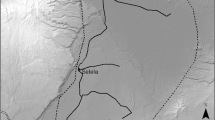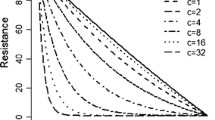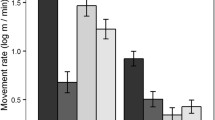Abstract
Movement of animals is a key process affecting population dynamics. Information on factors that affect pathway use is essential for identifying and protecting pathways, and important for maintaining connectivity among populations. We present an innovative, non-invasive, approach for predicting pathways of reintroduced Asiatic wild ass (Equus hemionus) in Israel, which is based on understanding the effects of landscape factors on pathways use. The approach includes: Predicting pathways, by employing a least cost pathway (LCP) GIS models based on several landscape factors, so as to efficiently direct a field survey and explore the wild ass’s general preferences of pathway types; Collecting empirical data by surveying the dung density of wild ass along each of the predicted pathways and using the data as an index of pathway use; Evaluating the predicted pathways against the empirical data collected, to estimate the general pathway preferences of the wild ass; and Developing and evaluating alternative generalized linear models, according to a priori hypotheses based on empirical data so as to quantify the effect of different landscape factors on pathway use. The analyses were conducted for the entire landscape, and then for two distinct landscape types, open landscape and landscape-barriers (mountain ridges), as subsets of the entire landscape. There were clear differences in the mean number of faeces counts between the LCPs, indicating that the wild ass prefers certain pathway types as a function of landscape features. We further found that the factors affecting E. hemionus pathway usage—vegetation; slopes; canyons; and 4-wheel drive routes—varied largely between the two major landscape types studied, demonstrating the importance of studying space use patterns at different landscape terrains. This information can be applicable to landscape planning measures that aim to enhance protection of the species. This approach provides a framework for studying animal space-use patterns of a variety of species, including elusive species, in a heterogeneous landscape.



Similar content being viewed by others
References
Anderson D (2008) Model based inference in the life sciences: a primer on evidence. Springer, New York
Bar-David S, Saltz D, Dayan T, Perelberg A, Dolev A (2005) Demographic models and reality in reintroductions: Persian fallow deer in Israel. Conserv Biol 19:131–138
Beier P, Penrod KL, Luke C, Spencer W, Cabañero C (2005) South Coast Missing Linkages: restoring connectivity to wild lands in the largest metropolitan area in the United States. In: Crooks KR, Sanjayan MA (eds) Connectivity and conservation. Cambridge University Press, London, pp 555–586
Breslow N (1970) A generalized Kruskal–Wallis test for comparing K samples subject to unequal patterns of censorship. Biometrika 57:579
Brown JH, Kodric-Brown A (1977) Turnover rates in insular biogeography: effect of immigration on extinction. Ecology 58:445–449
Bruggeman JE, Garrott RA, White PJ, Watson FG, Wallen R (2007) Covariates affecting spatial variability in bison travel behavior in Yellowstone National Park. Ecol Appl 17:1411–1423
Buchmann CM, Schurr FM, Nathan R, Jeltsch F (2012) Movement upscaled—the importance of individual foraging movement for community response to habitat loss. Ecography 35:436–445
Burnham KP, Anderson DR (2002) Model selection and multimodel inference: a practical information-theoretic approach. Springer, New York
Chetkiewicz C-LB, Boyce MS (2009) Use of resource selection functions to identify conservation corridors. J Appl Ecol 46:1036–1047
Clobert J, Danchin E, Dhondt AA, Nichols JD (2001) Dispersal. Oxford University Press, New York
Crawley MJ (2007) The R book. Wiley, London
Dickson BG, Beier P (2007) Quantifying the influence of topographic position on cougar (Puma concolor) movement in southern California, USA. J Zool 271:270–277
Dobson FS, Jones WT (1985) Multiple causes of dispersal. Am Nat 126:855–858
Dolev A, Saltz D, Bar-David S, Yom-Tov Y (2002) Impact of repeated releases on space-use patterns of Persian fallow deer. J Wildl Manag 66:737–746
Dunham KM (1998) Spatial organization of mountain gazelles Gazella gazella reintroduced to central Arabia. J Zool 245:371–384
Faraway JJ (2006) Extending the linear model with R: generalized linear, mixed effects and nonparametric regression models. CRC Press, Boca Raton
Ferguson SH, Elkie PC (2004) Habitat requirements of boreal forest caribou during the travel seasons. Basic Appl Ecol 5:465–474
Fortin D, Beyer HL, Boyce MS, Smith DW, Duchesne T, Mao JS (2005) Wolves influence elk movements: behavior shapes a trophic cascade in Yellowstone National Park. Ecology 86:1320–1330
Ganskopp D, Cruz R, Johnson DE (2000) Least-effort pathways?: a GIS analysis of livestock trails in rugged terrain. Appl Anim Behav Sci 68:179–190
Groves CP (1986) The taxonomy, distribution and adaptations of recent equids. In: Meadows RH, Uerpmann HP (eds) Equids in the ancient world. Dr Ludwig Reichert Verlag, Wiesbaden, pp 11–65
Henley SR, Ward D, Schmidt I (2007) Habitat selection by two desert-adapted ungulates. J Arid Environ 70:39–48
Holyoak M, Casagrandi R, Nathan R, Revilla E, Spiegel O (2008) Trends and missing parts in the study of movement ecology. PNAS 105:19060–19065
IUCN (2001) IUCN Red List Categories and Criteria, Version 3.1. http://www.iucnredlist.org/technical-documents/categories-and-criteria/2001-categories-criteria. Accessed June 2013
Johnson CJ, Parker KL, Heard DC, Gillingham MP (2008) A multiscale behavioral approach to understanding the movements of woodland caribou. Ecol Appl 12:1840–1860
Kaczensky P, Ganbaatar O, von Wehrden H, Walzer C (2008) Resource selection by sympatric wild equids in the Mongolian Gobi. J Appl Ecol 45:1762–1769
Koenig WD, Van Vuren D, Hooge PN (1996) Detectability, philopatry, and the distribution of dispersal distances in vertebrates. Trends Ecol Evol 11:514–517
Laing SE, Buckland ST, Burn RW, Lambie D, Amphlett A (2003) Dung and nest surveys: estimating decay rates. J Appl Ecol 40:1102–1111
Loarie SR, Van Aarde RJ, Pimm SL (2009) Fences and artificial water affect African savannah elephant movement patterns. Biol Conserv 142:3086–3098
Long ES, Diefenbach DR, Wallingford BD, Rosenberry CS (2010) Influence of roads, rivers, and mountains on natal dispersal of white-tailed deer. J Wildl Manag 74:1242–1249
Lozano J, Virgós E, Malo AF, Huertas DL, Casanovas JG (2003) Importance of scrub–pastureland mosaics for wild-living cats occurrence in a Mediterranean area: implications for the conservation of the wildcat (Felis silvestris). Biodivers Conserv 12:921–935
Lunney D, Phillips S, Callaghan J (1998) Determining the distribution of koala habitat across a shire as a basis for conservation: a case study from Port Stephens, New South Wales. Pac Conserv Biol 4:186–196
McCoy J, Johnston K (2001) Using ArcGIS spatial analyst. ESRI Press, New York
Murtskhvaladze M, Gavashelishvili A, Tarkhnishvili D (2010) Geographic and genetic boundaries of brown bear (Ursus arctos) population in the Caucasus. Mol Ecol 19:1829–1841
Nathan R, Getz WM, Revilla E, Holyoak M, Kadmon R, Saltz D, Smouse PE (2008) A movement ecology paradigm for unifying organismal movement research. Proc Natl Acad Sci USA 105:19052–19059
Nezer O (2011) The use of predicted distribution model of the Asiatic wild ass (Equus hemionus) for sustainable management of the Negev and the Arava. Thesis, Technion, Institute of Technology
Peled T (2010) Reintroductions as an ecosystem restoration tool: a case study of reintroduced ungulates as vectors for seed-dispersal. Thesis, Ben-Gurion University of the Negev
Perelberg A, Saltz D, Bar-David S, Dolev A, Yom-Tov Y (2003) Seasonal and circadian changes in the home ranges of reintroduced Persian fallow deer. J Wildl Manag 67:485–492
R Development Core Team (2005) R: a language and environment for statistical computing. R Foundation for Statistical Computing, Vienna, Austria. http://www.R-project.org. Accessed June 2013
Redfern JV, Grant R, Biggs H, Getz WM (2003) Surface-water constraints on herbivore foraging in the Kruger National Park, South Africa. Ecology 84:2092–2107
Riley SPD, Pollinger JP, Sauvajot RM, York EC, Bromley C, Fuller TK, Wayne RK (2006) A southern California freeway is a physical and social barrier to gene flow in carnivores. Mol Ecol 15:1733–1741
Rueness EK, Stenseth NC, O’Donoghue M, Boutin S, Ellegren H, Jakobsen KS (2003) Ecological and genetic spatial structuring in the Canadian lynx. Nature 425:69–72
Saccheri I, Kuussaari M, Kankare M, Vikman P, Fortelius W, Hanski I (1998) Inbreeding and extinction in a butterfly metapopulation. Nature 392:491–494
Saltz D, Rubenstein DI (1995) Population dynamics of a reintroduced Asiatic wild ass (Equus hemionus) herd. Ecol Appl 5:327–335
Saltz D, Rowen M, Rubenstein DI (2000) The effect of space-use patterns of reintroduced Asiatic wild ass on effective population size. Conserv Biol 14:1852–1861
Sarrazin F, Barbault R (1996) Reintroduction: challenges and lessons for basic ecology. Trends Ecol Evol 11:474–478
Sharma BD, Clevers J, De Graaf R, Chapagain NR (2004) Mapping Equus kiang (Tibetan Wild Ass) Habitat in Surkhang, Upper Mustang, Nepal. Mt Res Dev 24:149–156
Sharp A, Norton M, Marks Holmes K A, Holmes K (2001) An evaluation of two indices of red fox (Vulpes vulpes) abundance in an arid environment. Wildl Res 28:419–424
Stern E, Gradus Y, Meir A, Krakover S, Tsoar H (1986) Atlas of the Negev. Keter Publishing House, Jerusalem
Tallmon DA, Luikart G, Waples RS (2004) The alluring simplicity and complex reality of genetic rescue. Trends Ecol Evol 19:489–496
Taylor LR, Taylor RA (1977) Aggregation, migration and population mechanics. Nature 265:415–421
Trakhtenbrot A, Nathan R, Perry G, Richardson DM (2005) The importance of long-distance dispersal in biodiversity conservation. Divers Distrib 11:173–181
Trombulak SC, Frissell CA (2000) Review of ecological effects of roads on terrestrial and aquatic communities. Conserv Biol 14:18–30
Turchin P (1996) Fractal analyses of animal movement: a critique. Ecology 77:2086–2090
Wennergren U, Ruckelshaus M, Kareiva P (1995) The promise and limitations of spatial models in conservation biology. Oikos 74:349–356
Wiens JA, Chr N, Van Horne B, Ims RA (1993) Ecological mechanisms and landscape ecology. Oikos 66:369–380
Yott A, Rosatte R, Schaefer JA, Hamr J, Fryxell J (2011) Movement and spread of a founding population of reintroduced elk (Cervus elaphus) in Ontario, Canada. Restor Ecol 19:70–77
Yousef MK, Dill DB, Freeland DV (1972) Energetic cost of grade walking in man and burro, Equus asinus: desert and mountain. J Appl Physiol 33:337–340
Acknowledgments
We would like to thank Oded Nezer, Tomer Gueta, Yishay Hofman, Aviva Peeters, Dror Kapota, David Saltz, Alan R. Templeton, Amos Bouskila, Guy Rotem, and Gal Vine for their valuable contributions to this study. This research was supported by the United States-Israel Binational Science Foundation Grant 2009296 awarded to S. Bar-David and A.R. Templeton and by the Israel Nature and Park Authority. This is publication 808 of the Mitrani Department of Desert Ecology.
Author information
Authors and Affiliations
Corresponding author
Electronic supplementary material
Below is the link to the electronic supplementary material.
Rights and permissions
About this article
Cite this article
Davidson, A., Carmel, Y. & Bar-David, S. Characterizing wild ass pathways using a non-invasive approach: applying least-cost path modelling to guide field surveys and a model selection analysis. Landscape Ecol 28, 1465–1478 (2013). https://doi.org/10.1007/s10980-013-9915-8
Received:
Accepted:
Published:
Issue Date:
DOI: https://doi.org/10.1007/s10980-013-9915-8




